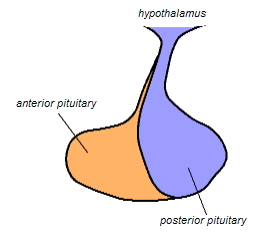Posterior pituitary
|
|
The posterior pituitary (also called the neurohypophysis) comprises the posterior lobe of the pituitary gland and is part of the endocrine system. It consists mainly of neurons extending from supraoptic nucleus and paraventricular nucleus in the hypothalamus that secrete peptide hormones into the bloodstream.
Anatomy and development
Despite its name, the posterior pituitary gland is not a gland, per se; rather, it is largely a collection of axonal projections from the hypothalamus that terminate behind the anterior pituitary gland. Like the anterior pituitary, this tissue receives its blood supply from the hypophyseal artery, and secretes hormones into the hypophyseal vein.
During development, part of the neural ectoderm evaginates and forms a structure called Rathke's pouch. This later develops into the posterior pituitary.
Major hormones secreted
Hormones known classically as posterior pituitary hormones are actually synthesized by the hypothalamus. They are stored and secreted by the posterior pituitary into the bloodstream.
| Hormone | Target | Effect |
| Oxytocin | Uterus, mammary glands | Uterine contractions; lactation |
| Vasopressin (antidiuretic hormone; ADH) | Kidneys | Stimulate water retention |
| Endocrine system - Pituitary gland | edit (https://academickids.com:443/encyclopedia/index.php?title=Template:Pituitary_gland&action=edit) |
| Posterior pituitary - Pars nervosa - Median emminence - Infundibular stalk | |
| Anterior pituitary - Pars intermedia - Pars tuberalis - Pars distalis - Somatotropes - Lactotropes - Thyrotropes - Gonadotropes - Corticotropes |

